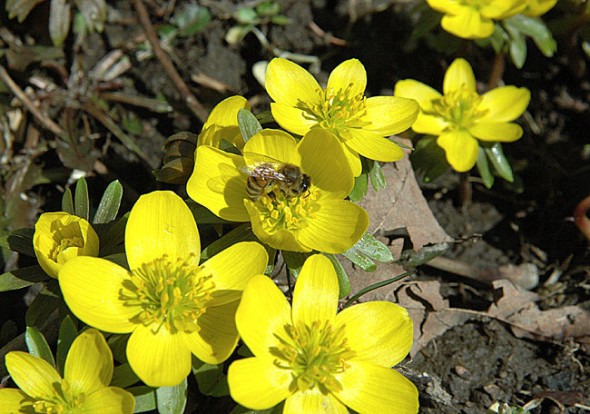
"If you enjoy oranges, apples, avocados, beans, herbs, tomatoes, peppers and many other tasty foods, bee decline should alarm you," wrote Macy Reynolds in her most recent contribution to the "Down to Earth" column. (Submitted photo)
Down to Earth | Foster ‘bee-luscious’ habitat
- Published: June 12, 2023
By Macy Reynolds
What a beautiful spring we’ve had, with flowering trees everywhere we look! We enjoy the multitude of fragrant blossoms, but for emerging native bees, these flowers provide necessary protein (pollen) and energy (nectar). Amazingly, native bees provide humans with one of every three bites of food we eat — our fruits, herbs and vegetables. And while native bees are responsible for 87% of that bite, honeybees only give us 13%. As important as native bees are for our food, most people probably couldn’t identify even 10 of the 400 Ohio species.
So where do they live?
Are they in danger?
How did I not know this?
A few of the more familiar native bees are bumblebees, carpenter bees and mason bees. Some of these bee species live in the ground, and others live in cavities, including the ends of dead plant stalks, chinks in concrete or in a pile of leaves. Bee activity for each species usually lasts three to five weeks during the growing season. Then the female dies while the eggs slowly develop into larvae, which become adult bees when they emerge the next year. The timing depends on the species, but it goes from February to August. If they emerge and the flowers or habitat they depend on for nutrition or nesting are not there, the bee will not produce a new brood and may never be at that site again. As an aside, it’s a colony of carnivorous wasps that swarms out of the ground and stings you. Ground-dwelling bees are solitary and vegetarian.
Since 1950, native bee populations have dropped by about 50%, mostly due to the loss of habitat and floral variety. The effect has been that now we harvest fewer fruits and vegetables in our orchards and gardens. If you enjoy oranges, apples, avocados, beans, herbs, tomatoes, peppers and many other tasty foods, bee decline should alarm you. For instance, your vegetable plants are pollinated by bumblebees. Almonds, apples, and many fruits are pollinated by mason bees. Honeybees do pollinate some of our favorite foods, but not as efficiently or as carefully as native bees. And honeybees are in trouble too.
You can do a lot to help native bees succeed. First, eliminate invasive plants, trees and shrubs from private property, school grounds and parks. Invasive species replace the familiar native plants, which bees have evolved with over millions of years. Some bees are generalists and can use pollen from a variety of plants, but others are specialists and must have pollen from a single plant species to feed overwintering larvae.
You can encourage larger populations of bees by leaving a pile of leaves and a pile of sticks or branches in your yard as overwintering habitat. And undisturbed bare ground will provide homes to ground-dwelling native bees. Allow the violets, dandelions, clover, spring beauties and other low-growing plants to grow with your grass for early bee food. And don’t use pesticides. A yard with clover is a bee’s smorgasbord.
Finally, make your property part of a corridor of yards so a bee can travel easily from flower to flower with her load of pollen. According to Dr. Doug Tallamy, planting 70% of your yard in native trees, flowers and shrubs will increase the number of bees that survive. A small native bee can travel about a football-field’s distance. A larger bee can travel up to a mile or more. Linking your yard to a string of parks, schools and other yards with bee-friendly habitats creates a healthy, bee-luscious habitat while treated lawns are a bee’s food dessert.
The Yellow Spring bee corridor has good anchors — the Glen’s five-acre prairie on Hyde Road, the bike path, the Glen, all the National Wildlife certified yards, the Women’s Park, Antioch campus and Glass Farm. Our native bees have always been here — they can’t fly far enough to go elsewhere — so what we eat in our future could depend on how well we develop and protect their habitat by removing invasive plants and providing plenty of native plants.
* A retired public school teacher, the author is a Master Gardener in Greene County, with Ohio MG certifications in weeds, trees, insects and native bees.
The Yellow Springs News encourages respectful discussion of this article.
You must login to post a comment.
Don't have a login? Register for a free YSNews.com account.















No comments yet for this article.